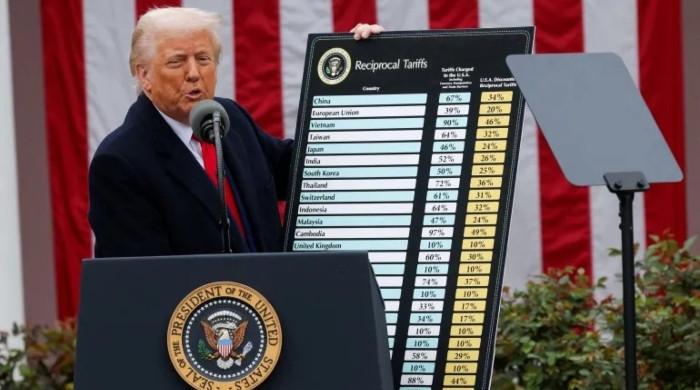Writing history
It is always a difficult task for historians to write textbooks of a country which is populated by different racial, linguistic, ethnic and religious groups
November 13, 2017

It is assumed that American society is a melting pot which assimilated and integrated all immigrants who arrived in the new world. It appears that the assumption is not wholly correct. The immigrants who came to the US always tried to associate with the community belonging to their former countries and retained their identities as Irish, Greek, or Italian.
However, the phenomenon of identity becomes confusing when the black community is referred to as Afro-American, Indians as Indo-American and Pakistanis as Pakistani-American, signifying their double identity. Albeit, it is true that in 1776 when 13 colonies revolted against Britain, an attempt was made to unite all of them as one nation on the basis of nationalism. After independence, though, local identities surfaced to break the unity.
Nevertheless, textbooks are used to inspire American students to be proud of their country’s founding fathers and the efforts of militia and common people who fought bloody battles against Britain. Joseph Moreau in his book, ‘Schoolbook nation: Conflicts over American history textbooks from the Civil War to the present’, discusses the problems faced by the authors in writing textbooks. According to Moreau, the concept of national unity was broken when the northern and southern American colonies developed their culture on different grounds.
In the southern states, white people own great plantations which were cultivated and laboured by the African slaves. As a result, the lifestyle of white people in the southern states developed drastically different from those in the northern states. The southerners possessed great wealth, built palatial houses, and enjoyed the luxuries of life to protect their wealth and highly privileged status. They used religion as well as racism, and justified the institution of slavery, treated slaves half humans who were deprived of human sensibilities. This racial prejudice, religious fanaticism and feudal values were fully reflected in their textbooks.
On the other hand, the northern states were industrial, following democratic institutions and traditions which liberalised their mindset. Their textbooks represented this outlook. The civil war, which was fought between the southern and northern states from 1861 to 1865, led to the defeat of the southern states and restoration of the union. As a result of that, textbooks were changed to readjust the newly transformed political system. Efforts were made to eliminate the racial prejudices that showed people of African origin as less intelligent than white people. However, despite all these efforts, racial discrimination in the US continues till today.
Another difficulty for textbook authors was how to describe the suffering and pain of the local Indian tribes whose land was occupied by white people by force; they were massacred them whenever they resisted against the white occupiers. Here, the interpretation of history becomes different. To the white people, America was a land of opportunity where they could settle and acquire as much land as they could. To the Indians, the arrival of the Europeans to their country and their brutal behaviour towards them was disastrous to their very existence. One Native American lamented that whenever he read textbooks about the heroes of the white people and their adventures and achievements he realised that they were the people who had robbed Native Americans’ lands and killed them indiscriminately; how could he then recognise them as heroes?
Another problem the authors of textbooks faced was the sectarian conflict between Protestants and Catholics. As most of the English settlers were Protestants, they had deep-rooted hatred against Catholics. Therefore, it was difficult to figure out how to reconcile these sectarian differences. With the arrival of the Jews, there was another question: how to re-adjust their religious beliefs and integrate them into American society?
American society was further changed when immigrants from different European countries such as Italy and Eastern Europe arrived on its shores. These immigrants were eager to retain their identity, history and culture. They also wished that their national traditions should be included in American textbooks. However, as the earlier settlers were Anglo Saxons, they wanted to keep their historical and cultural relationship with Britain. These relationships were briefly discontinued during the war of independence but revived afterwards and it became a matter of pride to have English values – something that distinguished them from other ethnic groups.
It is always a difficult task for historians to write textbooks of a country which is populated by different racial, linguistic, ethnic and religious groups. The challenge is how to represent them all and at the same time not resort to any prejudice and discrimination.
American historians have learnt how to readjust the political and social changes in society while writing textbooks. Their major concern is to create strong feelings of American nationalism so that students can be inspired regarding its greatness and grandeur. These textbooks have, however, failed to mention American imperialism and its interference in other countries which resulted in war and bloodshed.
These textbooks provide no knowledge of American invasions and their brutish behaviour towards other nations. They do not have any sense of guilt and shame. On the contrary, they are proud of their nation and its imperialism. If textbooks teach distorted history, the mind of young students is polluted and this conditioning continues throughout their lives.
The authors of Pakistani textbooks should learn a lesson from the experience of other countries on how to represent their religious and ethnic minorities and marginalised groups in school textbooks in order to create a sense of unity and nationhood.
The writer is a veteran historian and scholar.
Originally published in The News











